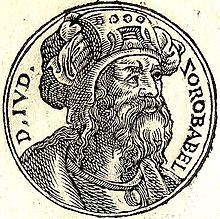
The idea of dual messiahs is the belief that there are either two messiahs or one messiah assuming the role of two. Later-Judaism talks about two messiahs — sons respectively of Joseph and of David.
Likewise in the Book of Zechariah, the Prophet Zechariah describes the construction of a future "Temple of the Lord" in Jerusalem where two rulers are anointed to serve and rule. Rather than being the sons of David and Joseph, these dual messiahs act as complementary leaders, one serving as the Davidic monarch and the other as the High Priest. In this instance, the two figures, Zerubbabel and Yeshua ben Yehozadak, are described as two olive trees which stand on either side of a golden lampstand. They are described as "the two who are anointed to serve the Lord of all the earth."
See also
References
- Julien Smith (2011). Christ the Ideal King: Cultural Context, Rhetorical Strategy, and the Power of Divine Monarchy in Ephesians. Mohr Siebeck. pp. 112–. ISBN 978-3-16-150974-2. Retrieved 14 August 2013.
- John Joseph Collins (1998). The Apocalyptic Imagination: An Introduction to Jewish Apocalyptic Literature. Wm. B. Eerdmans Publishing. pp. 161–. ISBN 978-0-8028-4371-5. Retrieved 14 August 2013.
- Jewish tradition speaks of two redeemers, each one called Mashiach. Both are involved in ushering in the Messianic era. They are Mashiach ben David and Mashiach ben Yossef. See Sukah 52b; Zohar I:25b; ibid. II:120a, III:153b, 246b and 252a.
- Stephen M. Wylen (1 January 1995). The Jews in the Time of Jesus: An Introduction. Paulist Press. pp. 171. ISBN 978-0-8091-3610-0. Retrieved 14 August 2013.
- Zechariah 6:9-15
- Zechariah 4:1-14